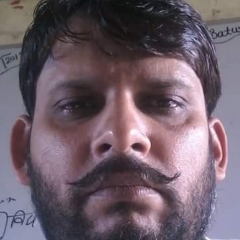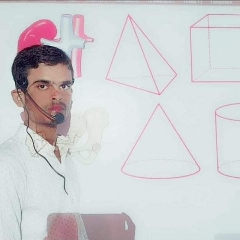Question 1 :
Total number of equivalence relation defined in the set $s=\{a, b, c\}$ is
Question 3 :
Let $f:R\rightarrow R$ be defined by $f(x)=2x+6$ which is a bijective mapping then ${ f }^{ -1 }(x)\quad $ is given by
Question 4 :
Let $f: N \rightarrow N$ be defined by $f(x) = x^2 + x + 1, x \in N$. Then $f$ is
Question 6 :
Let $f:{x, y, z}\rightarrow (a, b, c)$ be a one-one function. It is known that only one of the following statements is true:(i) $f(x)\neq b$<br/>(ii)$f(y)=b$<br/>(iii)$f(z)\neq  a$
Question 8 :
Let $f:R\rightarrow R$ be a function defined by $f(x)=\cfrac { { e }^{ \left| x \right|  }-{ e }^{ -x } }{ { e }^{ x }+{ e }^{ -x } } $, then
Question 9 :
Let $f:\{x, y , z\} \rightarrow \{1, 2, 3\}$ be a one-one mapping such that only one of the following three statements and remaining two are false : $f(x) \neq 2, f(y) =2, f(z) \neq 1$, then
Question 10 :
Let $f:N\rightarrow N$ ($N$ being the set of positive integers) be a function defined by $f(x)=$ the biggest positive integer obtained by reshuffling the digits of $x$. For example, $f(296)=962$<br>$f$ is
Question 11 :
If $A=\left[ \begin{matrix} 1 & -2 & 3 \end{matrix} \right] $     $B=\left[ \begin{matrix} -1 \\ 2 \\ -3 \end{matrix} \right] $, then $A + B$:<br/>
Question 12 :
If $A$ is a square matrix such that $A^{2} = I$, then $(A - I)^{3} + (A + I)^{3} - 7A$ is equal to
Question 13 :
If $A = \left[ \begin{array} { r r } { 2 } & { - 3 } \\ { - 4 } & { 1 } \end{array} \right] ,$ then adj $\left( 3 A ^ { 2 } + 12 A \right)$ isequal to :
Question 14 :
If $A$ and $B$ are two matrices of same order, then $A + B$ is equal to
Question 15 :
The restriction on $ n, k$ and $p$ so that $PY + WY$ will be defined are:<br>
Question 16 :
If the number of elements in a matrix is $60$ then how many different order of matrix are possible 
Question 17 :
A is of order $m \times n$ and B is of order $p \times q$, addition of A and B is possible only if<br>
Question 18 :
If $\begin{vmatrix} x-4 & 2x & 2x \\ 2x & x-4 & 2x \\ 2x & 2x & x-4 \end{vmatrix}$ = $(A+Bx)(x-A)^2$,<br>then the ordered pair $(A , B)$ is equal to:
Question 19 :
Let $C_k =$ $^nC_k$ for $0\leq k\leq n$ and<br>$A_k=\begin{bmatrix}C_{k-1}^2&0 \\0 &C_k^2 \end{bmatrix}$ for $k\geq 1$, and $A_1+A_2+ ... + A_n=\begin{bmatrix}k_1 &0 \\0 &k_2\end{bmatrix}$, then<br>
Question 20 :
If $A$ is $2\times 3$ matrix and $AB$ is a $2\times 5$ matrix, then $B$ must be a
Question 21 :
If $sin^{-1}$ a is the acute angle between the curves $x^2+y^2=4x$ and $x^2+y^2=8$ at (2, 2), then a= _____<br>
Question 22 :
Number of triplets $\left ( x, y, z \right )$ satisfying $\sin ^{-1}x+\sin ^{-1}y+\cos ^{-1}z=2\pi$ is<br>
Question 23 :
The sum of the solution of the equation $\displaystyle 2\:sin^{-1}\sqrt{x^{2}+x+1}+cos^{-1}\sqrt{x^{2}+x}=\frac{3\pi}{2}$ is
Question 25 :
If $\cos^{-1}\left (\dfrac {1 - x^{2}}{1 + x^{2}}\right ) + \cos^{-1}\left (\dfrac {1 - y^{2}}{1 + y^{2}}\right ) = \dfrac {\pi}{2}$, where $xy < 1$, then
Question 26 :
If $\alpha$ and $\beta$ are two real values of x which satisfy the equation $sin^{-1} x + sin^{-1} (1 - x) = cos^{-1} x$, then
Question 27 :
Domain of $f(x)=\cot ^{ -1 }{ x } +\cos ^{ -1 }{ x } +co\sec ^{ -1 }{ x } $ is
Question 28 :
The number of solution of the equation $ 1+x^{2}+2x\:\sin \left ( \cos^{-1}y \right )= 0 $ is :
Question 29 :
Let $a, b, c$ be a positive real numbers $\theta = \tan^{-1} \sqrt{\dfrac{a(a + b +c)}{bc}} + \tan^{-1} \sqrt{\dfrac{b(a + b+ c)}{ca}} + \tan^{-1} \sqrt{\dfrac{c(a + b + c)}{ab}}$, then $\tan \theta$<br>
Question 30 :
The value of $a$ for which $\displaystyle ax^{2}+sin^{-1}(x^{2}-2x+2)+cos^{-1}(x^{2}-2x+2)=0$ has areal solution is
Question 31 :
If the coordinates of the vertices of a triangle are (0,0) , (0,2) and(3,1) , then area of the triangle is<br>
Question 32 :
If bc +qr = ca + rp = ab + pq = -1 then the value of$\displaystyle \begin{vmatrix}ap& a & p\\bq & b & q\\cr & c & r\end{vmatrix}$ is
Question 33 :
If ${ \Delta }_{ r }=\begin{vmatrix} { a }^{ r } & { b }^{ r } & { c }^{ r } \\ a & b & c \\ 1-a & 1-b & 1-c \end{vmatrix}$. If $\displaystyle \sum _{ r=0 }^{ \infty }{ { \Delta }_{ r } } =0$, then which statement is true.
Question 34 :
If $\displaystyle 1,\omega ,\omega^{2} $ are cube roots of unity then $\displaystyle\begin{vmatrix}1 &\omega^{n} &\omega^{2n} \\\omega^{n} &\omega^{2n} &1 \\\omega ^{2n} &1 &\omega^{n} \end{vmatrix}$ equals<br>
Question 35 :
<br/>Let $\displaystyle f(\theta)=\begin{vmatrix}\cos\dfrac{\theta}{2}<br/> &1  &1 \\1 &\cos \dfrac{\theta}{2}  &-\cos\dfrac{\theta}{2} \\-\cos\dfrac{\theta}{2}  &1  &-1 \end{vmatrix}$ <br> $\displaystyle f(\pi) +f(-\pi) $ is equal to
Question 36 :
If $S=\left\{x\epsilon [0, 2\pi ]:\begin{vmatrix} 0 & \cos x & -\sin x\\ \sin x & 0 & \cos x\\ \cos x & \sin x & 0\end{vmatrix}=0\right\}$, then $\displaystyle \sum_{x\epsilon S}\tan\left(\displaystyle\frac{\pi}{3}+x\right)$ is equal to
Question 37 :
Let f (n)= $\displaystyle \left | \begin{matrix}n &n+1 &n+2 \\^{n}P_{n}&^{n+1}P_{n+1} &^{n+2}P_{n+2} \\^{n}C_{n}&^{n+1}C_{n+1} &^{n+2}C_{n+2}\end{matrix} \right |,$ where the symbols have their usual meanings. The $f(n)$ is divisible by
Question 38 :
Assertion: $\displaystyle \Delta =\begin{vmatrix}<br><br>\sin \pi & \cos(x+\pi/4) & \tan(x-\pi/4)\\ <br><br>\sin(x-\pi/4) & -\cos(\pi/2) & \log(x/y)\\ <br><br>\cot(\pi/4+x) & \log(y/x) & \tan \pi<br><br>\end{vmatrix}=0$
Reason: A skew symmetric determinant of odd order equals $0$
Question 39 :
Let n and r be two positive integers such that $n \geq r + 2$. Suppose $\Delta (n, r) =\begin{vmatrix}^nC_r & ^nC_{r + 1} & ^nC_{r + 2}\\ ^{n+1}C_r & ^{n + 1}C_{r + 1} & ^{n + 1}C_{r + 2}\\ ^{n + 2}C_r & ^{n + 2}C_{r + 1}& ^{n + 2} C_{r + 2}\end{vmatrix}$ Show that $\Delta(n, r) \displaystyle = \frac{^{n + 2} C_3}{^{n+ 2} C_3} \Delta (n - 2, r - 1)$ Hence or otherwise,
Question 40 :
If $\displaystyle f(x)=\begin{bmatrix}\sin x &\ cosec x &\tan x \\\sec x &x\sin x &x\tan x \\x^{2}-1 &\cos x &x^{2}+1 \end{bmatrix}$ then $\displaystyle \int_{-a}^{a}\left | f(x) \right |dx $ equals<br>
Question 41 :
A point on the parabola $\mathrm{y}^{2}=18\mathrm{x}$ at which the ordinate increases at twice the rate of the abscissa is: <br/>
Question 42 :
The rate of change of area of a circle with respect to its radius at $r=2 \ cm$ is
Question 43 :
If the volume of spherical ball is increasing at the rate of $4\pi \ cc/sec$ then the rate of change of its surface area when the volume is $288\pi cc$ is
Question 44 :
The rate of change of the volume of a cone with respect to the radius of its base is-
Question 45 :
Two cyclist start from the junction of two perpendicular roads, their velocities being $3v$ metres/minute and $4v$ metres/minute . The rate at which the two cyclists are separating is
Question 46 :
Let $I$ be the purchase value of an equipment and $v(t)$ be the value after it has been used for $t$ years. The value $V(t)$ depreciates at a rate given by differential equation $\displaystyle \frac{\mathrm{d}\mathrm{V}(\mathrm{t})}{\mathrm{d}\mathrm{t}}=-\mathrm{k}(\mathrm{T-t})$, where $\mathrm{k}>0$ is a constant and $\mathrm{T}$ is the total life in years of the equipment. Then the scrap value $v(T)$ of the equipment is<br><br>
Question 47 :
The radius of a cylinder is increasing at the rate of $3m/s$ and its altitude is decreasing at the rate of $4m/s$. The rate of change of volume when radius is $4m$ and altitude is $6m$ is
Question 48 :
A point on the parabola ${ y }^{ 2 }=18x$ at which the ordinate increases at twice the rate of the abscissa is
Question 49 :
Find the max.value of the total surface of a right circular cylinder which can be inscribed in a sphere of radius a.
Question 50 :
A point moves along the curve $12y=x^3$ in such a way that the rate of increase of its ordinate is more than the rate of increase of abscissa. The abscissa of the point lies in the interval
Question 51 :
<br>lf $\mathrm{f}(\mathrm{x})=\left\{\begin{matrix}1+x &x\leq 1 \\3-ax^{2}& x>1\end{matrix}\right.$ is continuous at ${x}=1$ then ${a}=({a}>0)$<br>
Question 52 :
 If $\displaystyle f\left ( x \right )=\left\{\begin{matrix}\dfrac{\sin 3x+a\sin 2x+b\sin x}{x^{5}} &x\neq 0 \\c,  &x=0 \end{matrix}\right.$ is continuous at $x=0$, find the values of $a,b,c$.<br/>
Question 53 :
If $ f\left ( x \right )=\dfrac{\left ( a+x \right )^{2}\sin \left ( a+x \right )-a^{2}\sin a}{x},x\neq 0$, the value of $f(0)$ so that f is continuous at $x = 0$ is<br>
Question 54 :
The function $f(x)=\begin{cases} \cfrac { { e }^{ 1/x }-1 }{ { e }^{ 1/x }+1 } \\ 0,\quad \quad x=0 \end{cases},\quad x\neq 0$
Question 55 :
<br/>If the function $\displaystyle \mathrm{f}({x})=\begin{cases}\dfrac{2^{x+2}-16}{4^{x}-16}&&  for {x}\neq 2\\ \mathrm{A} && x =2\end{cases}$ is continuous at $x =2$, then $\mathrm{A}=$<br/>
Question 56 :
Assertion(A):$f(x)=\left\{\begin{array}{ll}x^{2}\sin(\frac{1}{x}) , & x\neq 0\\0, & x=0\end{array}\right.$ is continuous at ${x}=0$<br>Reason(R): Both $h(x)=x^{2},g(x)=<br>\left\{\begin{array}{ll}\sin(\frac{1}{x}) , & x\neq 0\\0, & x=0\end{array}\right.$are continuous at $x = 0$
Question 57 :
The function $f(x) = x - |x - x^2|, -1 \leq x \leq 1$ is continuous on the interval<br>
Question 58 :
The values of $p$ and $q$ so that the function $  f(x)=      \begin{cases} { \left| 1+\sin { x }  \right|  }^{ \tfrac { p }{ \sin { x }  }  }&\cfrac { -\pi  }{ 6 } <x<0 \\ q                    &x=0 \\ { e }^{ \tfrac { \sin { 2x }  }{ \sin { 3x }  }  } &0<x<\cfrac { \pi  }{ 6 }  \end{cases}$ is continuous at $x=0$ is
Question 59 :
If $\displaystyle f(x)=\frac{\sin 3x+A\sin 2x+B\sin x}{x^{5}}$ for $x\neq 0$ , is continuous at $x=0$, then
Question 60 :
Suppose that $\displaystyle f(\dfrac{1}{2})=1$ and f is continuous on $[0, 1]$ assuming only rational value in the entire interval. The number of such function is :<br/>
Question 61 :
What is $\int { (x^2 + 1)^{\frac{5}{2}}xdx}$ equal to ?<br>Where c is a constant of integration.
Question 63 :
The value of the integral $\displaystyle \int \frac{e^{7\log x} - e^{6\log x}}{e^{5\log x} - e^{4 \log x}} dx$ is equal to<br/>
Question 66 :
The integral $\displaystyle \int { \left( 1+2{ x }^{ 2 }+\frac { 1 }{ x } \right) } { e }^{ { x }^{ 2-\frac { 1 }{ x } } }dx$ is equal to
Question 67 :
Let f be a function defined for every x, such that f'' = -f ,f(0)=0, f' (0) = 1, then f(x) is equal to
Question 71 :
The area inside the parabola $5x^2-y=0$ but outside the parabola $2x^2-y+9=0$, is
Question 72 :
$Letf(x)={ sin }^{ -1 }(sin\quad x)+{ cos }^{ -1 }(\quad cos\quad x),\quad g(x)=mx\quad and\quad h(x)=x\quad $ are three functions. Now g(x) is divided area between f(x),x=$\pi $ and y=0 into two equal parts.<br/>The area bounded by the curve y=f(x), x=$\pi $ and y=0 is:
Question 73 :
The area of the region bounded by the parabola $(y-2)^2=(x-1)$, the tangent to the parabola at the point $(2, 3)$ and the X-axis is?
Question 74 :
<p>The area bounded by $y = f\left( x \right),x - axis$ and the line $y = 1$, where $f\left( x \right) = 1 + \dfrac{1}{x}\int\limits_1^x {f\left( t \right)dt} $  is</p>
Question 75 :
Find the area cut off from the parabola $4y={3x}^{2}$ by the straight line $2y=3x+12$.
Question 76 :
The area bounded by $y=2-\left| 2-x \right|$ and $y=\frac { 3 }{ \left| x \right|  }$ is :
Question 77 :
If f(x) be an increasing function defined on [a, b] then<br/>max {f(t) such that $a\leq t\leq x$, $a\leq x\leq b$}=f(x)  & min {f(t), $a\leq t\leq x$, $a\leq x\leq b$}=f(a) and if f(x) be decreasing function defined on [a, b] then<br/>max {f(t), $a\leq t\leq x$, $a\leq x\leq b$}=f(a),<br/>min {f(t), $a\leq t\leq x$, $a\leq x\leq b$}=f(x).<br/>On the basis of above information answer the following questions.<br/>$\int_{0}^{\pi }max\left \{ \sin x, \cos x \right \}dx$ is equal to<br/>
Question 78 :
The area bounded by the region by the curves $ \displaystyle \begin{vmatrix}x\end{vmatrix} =1-y^{2} $ and $ \displaystyle \begin{vmatrix}x\end{vmatrix}+\begin{vmatrix}y\end{vmatrix}=1 $ is<br>
Question 79 :
The area between the curves y=tan x, cot x and axis in the interval $\left[0,\pi   \right/2$]is ?
Question 80 :
I:The area bounded by the curves $y=\sin x,\ y=\cos x$ and $\mathrm{Y}$-axis is $\sqrt{2}-1$ sq. units.<br>II:The area bounded by $y=\cos x,\ y=x+1,\ y=0$ is 3/2 sq. units.<br><br>Which of the above statement is correct?<br>
Question 81 :
The order and degree of the differential equation $\left [1 + \left (\dfrac {dy}{dx}\right )^{2} \right ]^{3} = \rho^{2} \left [\dfrac {d^{2}y}{dx^{2}}\right ]^{2}$ are respectively.
Question 82 :
The degree of D.E $\left [ 5+\left ( \dfrac{dy}{dx} \right ) ^{2}\right ]^{5/3}=7\left ( \dfrac{d^{2}y}{dx^{2}} \right )$
Question 84 :
The subnormal at any point of a curve is of constant length '8'. Then the differential equation of the family of curves is
Question 85 :
For the differential equation ${ \left( \cfrac { dy }{ dx }  \right)  }^{ 2 }-x\left( \cfrac { dy }{ dx }  \right) +y=0$, which one of the following is not its solution?
Question 86 :
The order and degree of the differential equation ${ y }^{ 2 }=4a(x-a)$, where $a$ is an arbitrary constant, are respectively
Question 87 :
Consider the function $\mathrm{f}:(-\infty, \infty)\rightarrow(-\infty, \infty)$ defined by $\displaystyle \mathrm{f}(\mathrm{x})=\frac{\mathrm{x}^{2}-\mathrm{a}\mathrm{x}+1}{\mathrm{x}^{2}+\mathrm{a}\mathrm{x}+1}$ , $0<\mathrm{a}<2$.<br/>Which of the following is true?<br/>
Question 88 :
$\cfrac { d }{ dx } \left[ \tan ^{ -1 }{ \cfrac { \sqrt { 1+{ x }^{ 2 } } -1 }{ x } } \right] $ is equal to
Question 90 :
The order of the differential equation whose solution is $y=a\cos { x } +b\sin { x } +c{ e }^{ -x }$, is
Question 91 :
Which of the following statements about an LP problem and its dual is false?
Question 93 :
Conclude from the following:<br/>$n^2 > 10$, and n is a positive integer.A: $n^3$B: $50$
Question 94 :
Find the output of the program given below if$ x = 48$<br/>and $y = 60$<br/>10  $ READ x, y$<br/>20  $Let x = x/3$<br/>30  $ Let y = x + y + 8$<br/>40  $ z = \dfrac y4$<br/>50  $PRINT z$<br/>60  $End$
Question 95 :
If $x+y \leq 2, x\leq 0, y\leq 0$ the point at which maximum value of $3x+2y$ attained will be.<br/>
Question 96 :
If $\alpha,\ \beta,\ \gamma$ be the direction angles of a vector and $\cos\ \alpha=\dfrac{14}{15}$,$\cos\ \beta=\dfrac{1}{3}$, then $\cos\ \gamma=$
Question 97 :
If $\overline {e} = l\overline {i} + m\overline {j} + n\overline {k}$ is a unit vector, the maximum value of $lm + mn + nl$ is
Question 98 :
The vector sum of (N) coplanar forces, each of magnitude F, when each force is making an angle of<br/>$\frac{2\pi }{N}$ with that preceding one, is :<br/>
Question 99 :
If a, b, c are position vectors of the vertices of a $\displaystyle \Delta ABC,$ then $ \displaystyle \overrightarrow{AB}+\overrightarrow{BC}+\overrightarrow{CA}=$
Question 100 :
If the vectors $\vec{a} = 2\hat{i} + 3\hat{j} - 6\hat{k} \, and \, \hat{b} = x\hat{i} - \hat{j} + 2\hat{k}$ are parallel, then x =
Question 103 :
The three points A, B, C with position vectors $-2a+3b+5c, a+2b+3c, 7a-c$ <br/>
Question 104 :
<p>If the sum of two unit vectors is also a unit vector, then the angle between the two vectors is</p>
Question 106 :
A straight line passes through (1, -2, 3) and perpendicular to the plane $2x + 3y - z = 7$.Find the direction ratios of normal to plane.  
Question 107 :
A st. line which makes angle of $\displaystyle 60^{\circ}$ with each of y - and z - axes, is inclined with x - axis at an angle
Question 108 :
The projection of the line segment joining $(0, 0, 0)$ and $(5, 2, 4)$ on the line whose direction ratios are $2, -3, 6$ is<br/>
Question 109 :
A line passes through the point $(6,-7, -1)$ and $(2,-3,1)$. if the angle $\alpha$ which the line makes with the positive direction of x-axis is acute, the direction cosines of the line are,
Question 110 :
The direction`cosines of a line equally inclined to three mutually perpendicular lines having D.C.'s as ${\ell _1}{m_1}{n_1}:{\ell _2}{m_2}{n_2}:{\ell _3}{m_3}{n_3}\,\,$ are 
Question 111 :
The direction ratios of the diagonal of a cube which joins the origin to the opposite corner are (when the three concurrent edges of the cube are coordinate axes)
Question 112 :
If $\alpha,\beta,\gamma\in[0,2\pi]$, then the sum of all possible values of $\alpha, \beta,\gamma$ if $\sin \alpha=-\dfrac{1}{\sqrt{2}}$, $\cos \beta=-\dfrac{1}{2}$, $\tan \gamma=-\sqrt{3}$, is
Question 113 :
A plane mirror is placed at the origin so that the direction ratios of its normal are $(1,-1,1)$. A ray of light, coming along the positive direction of the x-axis, strikes the mirror. The direction cosines of the reflected ray are
Question 114 :
The projections of a line segment on $x, y, z$ axes are $12, 4, 3$. The length and the direction cosines of the line segments are
Question 115 :
If$\displaystyle l_{1},m_{1},n_{1}$ and $\displaystyle l_{2},m_{2},n_{2}$ are D.C.'s of the twolines inclined to each other at an angle$\displaystyle \theta $, then theD. C.'s of the internal and external bisectors of theangle between these lines are
Question 116 :
There are 3 boxes each having two drawers The first box contains a gold coin in each drawer. The second, a gold coin in one drawer and a silver coin in the other. The third box contains a silver coin in each drawer. A box is chosen at random and a drawer is opened. If a gold coin is found in that drawer, then the probability that the other drawer also contains a gold coin is
Question 117 :
In a bolt factory, machines $A, B$ and $C$ manufacture $25 \%, 35 \%$ and $40 \%$ respectivelyof the total number of bolts. The percentage of defective bolts among the manufactured boltsis $5 \%$ for $A$ , $4 \%$ for $B$ and $2 \%$ for $C$. A bolt is drawn randomly from the manufactured products and is found to be defective then,
Question 118 :
For any two events $A$ and $B$ in a sample place
Question 119 :
For any two events $A$ and $B$ in a sample space<br>
Question 120 :
The ratio of the number of trucks along a highway, on which a petrol pump is located, to the number of cars running along the same highway is 3 : 2. It is known that an average of one truck in thirty trucks and two cars in fifty cars stop at the petrol pump to be filled up with the fuel. If a vehicle stops at the petrol pump to be filled up with the fuel, find the probability that it is a car<br>

























